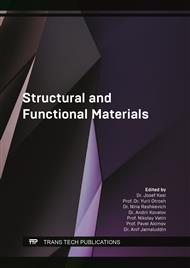p.202
p.209
p.217
p.225
p.233
p.240
p.246
p.253
p.259
Possibility of the Use of Ground Glass Break in the Production of Aerated Concrete
Abstract:
The possibility of using breakage of technical glass in conjunction with liquid glass to obtain aerated concrete by low-power technology is considered. The necessary strength is provided by finely ground unsorted breakage of technical glass with a specific surface area of 450, 500 and 550 m2/kg. The compressive strength of aerated concrete samples is 0.08; 0.25 and 1.8 MPa, and the bending strength is 0.04; 0.08 and 0.33 MPa, accordingly. The optimum is grinding to a specific surface area of 500-550 m2/kg, a finer grinding is irrational, because it does not lead to a significant increase in the surface of the particles. It is shown that the use of only finely ground cullet in the composition of aerated concrete is not effective, since the density of the samples increases with a significant decrease in strength due to the fragility of the interpore partitions. At the same time, thermal conductivity increases and the operating temperature range decreases to 400 °C, due to an increase in the fusibility of the material. It is necessary to reinforce the resulting partitions for the formation of a dense and durable structure. For this, it is proposed to use crushed cullet with particle size modulus 0.945. It has been experimentally established that the ratio between finely ground and crushed cullet should be in the range of 1.97 - 2.24. This ratio of components provides the necessary strength for aerated concrete based on liquid glass and unsorted broken technical glass. With an average density of aerated concrete in a dry state of 150 - 320 kg/m3, the compressive strength is might be up to 2.0 MPa and the bending strength is might be up to 0.38 MPa. The aerated concrete obtained in this work had a thermal conductivity coefficient of 0.05 – 0.09 W/(m°C), with an operating temperature range of-60 ... + 800 °C.
Info:
Periodical:
Pages:
233-239
Citation:
Online since:
July 2022
Authors:
Price:
Сopyright:
© 2022 Trans Tech Publications Ltd. All Rights Reserved
Share:
Citation:


